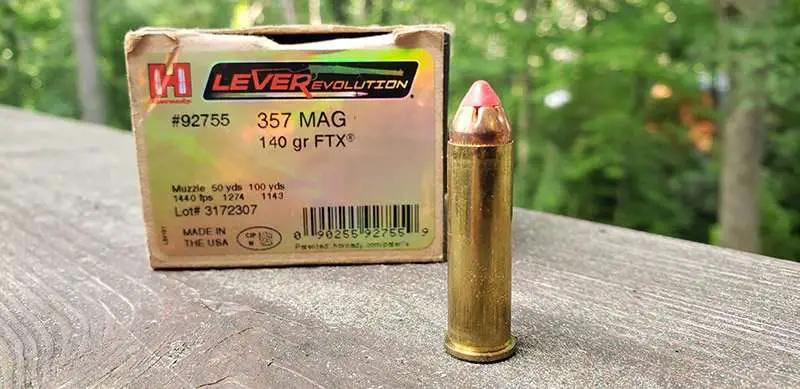
357 Magnum Cartridge:
The 357 Magnum cartridge was designed in 1934 and then introduced to the public in 1935 by Smith & Wesson. The 357 Magnum is an effective self-defense cartridge for those who carry a revolver and it started out back then as a very popular round.
S&W originally had a hard time keeping up with demand on the guns that shot it, and this cartridge was one of the first of the magnum cartridges.
Later, other magnums would be introduced like the 44 magnum, 32 H&R magnum, and eventually the 327 Federal magnum (as well as others) largely based on the work that Elmer Keith and the other early designers came out with back in the mid 30s.
This cartridge’s parent case is the 38 Special, but lengthened. And, while the 38 Special was originally designed to use a different kind of powder and loaded to lower pressures, the 357 was designed with smokeless powder and to be loaded to much higher pressures.
And in fact, that was its goal. It was designed to be a fast-moving, hard-hitting handgun cartridge that is also popular for carbines and hunting.
357 Magnum Uses:
The 357 Magnum is one of the most popular cartridges in the country, and with good reason. It can be used for hunting, self-defense, and in some cases dangerous animal defense.
Each time you use it, be sure to use the right type of ammunition for your purpose. When you use the right ammo, you’ll ensure your success.
For example, if you’re going to carry a 357 revolver for self-defense out in public, utilizing a good jacketed hollow point that is proven to expand and penetrate to the proper specs is key.
If you’re going to use the 357 magnum for bear defense, then you must utilize ammo that is designed to penetrate a thick-skinned animal like what you see with hard cast bullets.
357 Magnum Handgun Ballistics:
The 357 Magnum is capable of traveling 1,240 feet per second with 539 pound feet of energy at the muzzle with 158 grain target loads. 130 grain Hydra-Shok projectiles out of a 4″ barrel can hit 1,410 FPS with 574 FT/LB at the muzzle.
This first 357 magnum ballistics chart for handguns is for 130 grain Federal Hydra-Shok jacketed hollow point ammo. Zero is 25 yards.
| Muzzle | 25 YDS | 50 YDS | 100 YDS | |
| Velocity (FPS) | 1,410 | 1,331 | 1,258 | 1,138 |
| Energy (FT/LB) | 574 | 511 | 457 | 373 |
| Drop (Inches) | / | 0 | -.3 | -5.2 |
This 357 Magnum ballistics table is for 158 grain JSP (jacketed soft point) ammo tested out of a 4″ barrel and a 25 yard zero.
| Muzzle | 25 YDS | 50 YDS | 100 YDS | |
| Velocity (FPS) | 1,240 | 1,187 | 1,139 | 1,063 |
| Energy (FT/LB) | 539 | 494 | 455 | 396 |
| Drop (Inches) | / | 0 | -.6 | -7.1 |
This 357 magnum handgun ballistics chart is for 135 grain Hornady Critical Duty FlexLock fired from an 8″ barrel and a 25 yard zero:
| Muzzle | 25 YDS | 50 YDS | 100 YDS | |
| Velocity (FPS) | 1,275 | 1,208 | 1,150 | 1,058 |
| Energy (FT/LB) | 487 | 437 | 396 | 336 |
| Drop (Inches) | / | 0 | 0 | -5.1 |
357 Magnum Rifle:
There are now more than a few lever action rifle manufacturers who chamber 357 in their platforms.
Since its introduction it’s now being used in some light-weight carbine style rifles for hunting purposes like those being offered by Henry Repeating Arms.
The ballistics of the 357 Magnum cartridge normally reserved for handgun use changes dramatically in a rifle.
357 Mag Rifle Hunting:
While the 357 Magnum is no powerhouse cartridge for big game hunting, it is more than capable of taking white-tail deer out to about 75 yards reliably, and smaller white-tail deer out to 100 yards.
The bullet energy for the 357 Magnum fired from a rifle with a short 18 inch barrel at 100 yards can not be equaled by a 357 Magnum handgun with a long 8 inch barrel even at the muzzle.
So where does the 357 Magnum carbine rifle fit into the whole scheme of hunting?
For myself if I lived in an area where there were a lot of hogs and pigs that roam wildly, a nice fast handling 357 Magnum carbine rifle and handgun chambered in the same round would be the ideal hunting equipment needed for pig hunting.
357 Magnum Rifle Ballistics:
This 357 Magnum Rifle Ballistics Chart shows the 140 Grain Hornady FTX travels at 1,850 feet per second with 1,064 pounds of energy at the muzzle when fired from an 18 inch barrel. Velocity and energy slow to 1,458 and 660 at 100 yards, respectively.
Rifle Barrel Length: 18 Inches.
Ammuntion Used For Ballistics: Hornady 140 grain FTX (pictured above).
FTX: Flex Tip Extreme Expansion.
| Muzzle | 25 YDS | 50 YDS | 100 YDS | |
| Velocity (FPS) | 1,850 | 1,744 | 1,643 | 1,458 |
| Energy (FT/LB) | 1,064 | 945 | 839 | 660 |
| Drop (Inches) | / | 0 | +.8 | -.2 |
Reloading Information:
Bullet Diameter: .357 Inch.
Maximum Case Length: 1.290 Inches.
Trimmed Case Length: 1.280 Inches.
Primer Size: Small Pistol.
Maximum Cartridge Overall Length: 1.590 Inches.
Conclusion:
The 357 magnum is a versatile cartridge that can be used for both self-defense and hunting when the right ammo is used for either. Adding a lever action and revolver to your collection for either is a good idea for when SHTF, as well.

